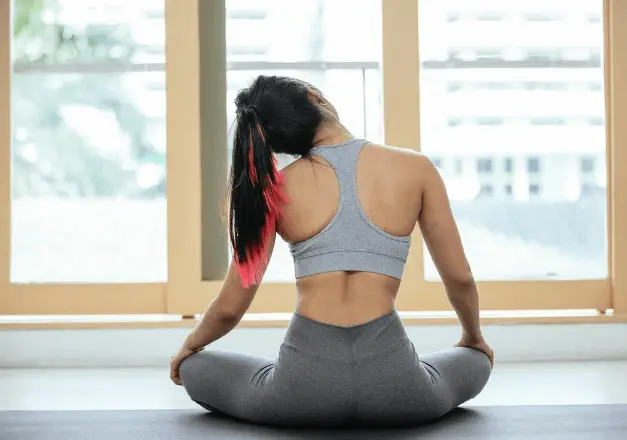Strong and flexible muscles and joints resist injuries and sprains. Muscles need movement, especially the muscles of the neck and your back. When these muscles are in one position without movement for long periods, it increases the risk of injury and strain.
Many people face this problem in the present day as most jobs require you to sit in front of computer screens for hours together. You may have landed on this article looking for a solution for the same. Isn’t it?
Neck and back strain has become the most common complaint of people in their daily lives, mainly those working at an IT company or even WFH (all because of Covid!) Take frequent short breaks for a few minutes from your work and stretch your muscles.
This will be very helpful to you in preventing the risk of injuries. The good part of this universal problem is that it can be solved by doing a few neck stretches and exercises.

Common Causes of neck pain and tightness
Some activities can cause neck pain and limit the range of motion such as
- Driving and sitting for long hours.
- Using laptops and cell phone use.
- Sleeping incorrectly.
- Reading and writing.
- Carrying heavy shoulder bags.
Here are a few neck exercises (you don’t have to worry much, they are extremely simple and easy). You can do these stretches throughout the day to decrease and prevent neck strain.
Bear in mind that these exercises should not cause any pain if you do them the right way. Moreover, you better avoid these exercises if you have an existing neck condition as they may aggravate your pain. Always consult your doctor or physiotherapist when doing new stretching exercises most importantly when you have such conditions.
Neck retraction
You can do this either in a seated or a standing position. This exercise can relieve pain, and loosen up your muscles. It can reduce spinal pressure as well.
- Start with looking straight and relaxing.
- Tuck down your chin slightly and place your fingers on the chin to move your head backwards gradually as far as you can without any pain.
- Make sure you do not tilt your head forward or backwards and continue looking ahead.
- Hold the position for about 5 seconds.
- Now, return to the starting position.
- Repeat this stretch 10 times. And do 3 to 4 sessions throughout the day or at once.
Neck rotation
You will feel the stretch on the sides of your neck. This stretch can be done in both seated and standing positions.
- Start by looking ahead and allow yourself to relax.
- Tuck down your chin slightly and move your head backwards gradually as far as you can without any pain.
- Turn your head to the right and the left. This movement must be gentle. Do not strain your neck.
- Hold the stretch for about 3 seconds on each side before moving to the opposite.
- Perform 10 reps in each direction.
- Do this twice a day.
Upward extension
Upward neck extension targets the front of your neck. Inhale and exhale while you do this movement. Avoid arching your back.
- Start in a seated position.
- Slowly bend your neck backwards and look at the ceiling.
- Hold the position for about 10 seconds and return to the starting position.
- Do 5 reps of this stretch.
This is a great way to prevent straining your neck while at work.
Lateral extension
In this exercise, put gentle pressure by using your hands. You can do this exercise every half hour or one hour to avoid neck strain more likely when your neck is in a steady position for long hours like working at a laptop screen.
- Stand or sit with your hands by your side.
- Engage your core to support the spine and push your shoulders back and down.
- Slowly lean your head to the left and use your left hand for gentle pressure and resistance.
- Hold the position for 5 to 10 seconds.
- Now, switch to the opposite side.
- Do 2 to 4 reps on each side.

Bed hangs
This is the best exercise to do before bed or right after waking up to relieve strain and accelerate circulation.
- Lie on the bed horizontally with your head, shoulders and upper back close to the edge.
- Gently move your body in such a way that your head can stretch along the side of the bed.
- Place your hands alongside your body.
- Hold this for about 30 seconds.
- Tuck your chin to your chest and release slowly. Shift your body back onto your bed with the help of your arms.
- Do this 1-3 times.
Towel pull
- Place a rolled towel around your neck.
- Hold the ends and slowly look up as far as you can while rolling your head over the towel.
- Put gentle pressure on the rolled towel to support your spine as you extend back your head.
- Avoid holding the position.
- Slowly come back to the starting position.
- Do 10 reps of this stretch.
Shoulder shrugs
Again, this is also a great exercise to do at work to relieve your neck muscles after long periods of work, especially when you work in front of a computer. You can do this every 30 minutes to prevent neck pain.
- Look straight ahead in front of you.
- Raise both shoulders.
- Hold the position for 5 seconds and return to the starting position.
- Perform 10 reps.
Scalene stretch
This stretching exercise works the muscles on the side of the neck connecting to the ribs.
- Intertwine your fingers at the base of the spine.
- Lower your right shoulder and tilt your head to the left as far as you can.
- Hold the position for about 20 to 30 seconds.
- Now, return to the starting position.
- Do the same on the opposite side.
- Perform 3 reps on each side.
Standing forward bend
This releases tension in your neck, head and back. With the help of the Standing forward bend position, you can also loosen up your legs and the spine.
- Start by standing straight with your feet hip-width apart or slightly wider.
- Hinge at your hips and lower your torso towards your legs.
- You can bend your knees at a comfortable angle.
- Place your hand on the floor or your legs based on your comfort.
- Now, draw your chin to your chest and let your head hang and move your head in any comfortable direction.
- Hold the position for a minute.
- Return to the starting position by pressing your hands on your thighs.
Ways to prevent neck pain and tightness
Neck problems are very common. However, there are numerous things that you can do to prevent them.
- Keep your screen at eye level: if your work requires you to sit for long periods in front of a computer or a laptop screen, then make sure you place the screens on a table at your eye level. Avoid looking down while working for such extended hours.
- Do not sit for long periods: if you are required to sit for many hours together, walk around for at least 5 to 10 minutes every hour. You may do some of the above stretches (read other articles on the Wryll app for more stretching exercises!) as well.
- Concentrate on your posture: a bad posture can lead to multiple complications. The best way to stay away from any sort of neck pain is to improve your posture. Keep checking your posture throughout the day.
- Sit on a chair that supports the natural curvature of the spine.
- Avoid sleeping on your stomach. Sleep on your side or your back with your head aligned with your body.
- Avoid carrying heavy shoulder bags and opt for backpacks instead.
- Get massages to relieve the tension in your muscles.
- Quit smoking at the earliest.

When to consult a doctor
It is necessary to see a doctor when you have multiple frequent injuries. Moreover, all the above stretching exercises should not cause any pain. If you experience pain while doing these exercises, it is an indication that you should talk to a doctor.
Furthermore, if you experience pain while doing normal regular daily activities, it could be because of an underlying problem. Severe pain, weakness, tingling and numbness are the signs that you need the advice of a certified physician.
Conclusion
Neck stretching exercises are a great way to relieve your neck tightness and pain. On top of that, these exercises will help you build muscle strength and restore the mobility of these muscles.
Choose the exercises that you feel work the best for you. It is equally important to know which exercises are hindering your progress. Incorporate these exercises into your everyday life even after you are free of pain. Do these exercises throughout the day or as part of the warmups in your long workout routine.
You will be amazed by the results you get from doing these exercises. They not only make you free from the pain, but they make your daily activities far easier than usual. It makes the job simpler as you get more comfortable with sitting or standing for long periods.
See a doctor if the pain is not relieved with the basic stretching exercises or if the exercises aggravate the pain. Long-lasting pain could be a sign of an injury. So, it is always recommended to take the advice of a physician or a fitness expert before starting a routine.
